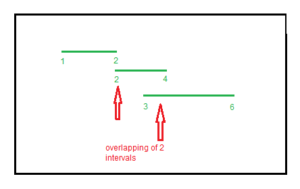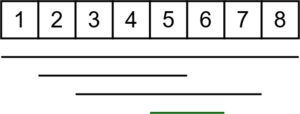给定不同的间隔,任务是随时打印这些间隔之间的最大重叠数。
例子:
Input: v = {{1, 2}, {2, 4}, {3, 6}}
Output: 2
The maximum overlapping is 2(between (1 2) and (2 4) or between (2 4) and (3 6))

Input: v = {{1, 8}, {2, 5}, {5, 6}, {3, 7}}
Output: 4
The maximum overlapping is 4 (between (1, 8), (2, 5), (5, 6) and (3, 7))

方法:
- 想法是将坐标存储在映射有字符“ x”和“ y”的一对新矢量中,以标识坐标。
- 排序向量。
- 遍历向量,如果遇到x坐标,则意味着添加了一个新范围,因此更新计数;如果遇到y坐标,则意味着减去了一个范围。
- 更新每个新坐标的计数值并取最大值。
C++
// C++ program that print maximum
// number of overlap
// among given ranges
#include
using namespace std;
// Function that print maximum
// overlap among ranges
void overlap(vector > v)
{
// variable to store the maximum
// count
int ans = 0;
int count = 0;
vector > data;
// storing the x and y
// coordinates in data vector
for (int i = 0; i < v.size(); i++) {
// pushing the x coordinate
data.push_back({ v[i].first, 'x' });
// pushing the y coordinate
data.push_back({ v[i].second, 'y' });
}
// sorting of ranges
sort(data.begin(), data.end());
// Traverse the data vector to
// count number of overlaps
for (int i = 0; i < data.size(); i++) {
// if x occur it means a new range
// is added so we increase count
if (data[i].second == 'x')
count++;
// if y occur it means a range
// is ended so we decrease count
if (data[i].second == 'y')
count--;
// updating the value of ans
// after every traversal
ans = max(ans, count);
}
// printing the maximum value
cout << ans << endl;
}
// Driver code
int main()
{
vector > v
= { { 1, 2 }, { 2, 4 }, { 3, 6 } };
overlap(v);
return 0;
} Java
// Java program that print maximum
// number of overlap among given ranges
import java.util.*;
import java.lang.*;
import java.io.*;
class GFG{
static class pair
{
int first;
char second;
pair(int first, char second)
{
this.first = first;
this.second = second;
}
}
// Function that print maximum
// overlap among ranges
static void overlap(int[][] v)
{
// Variable to store the maximum
// count
int ans = 0;
int count = 0;
ArrayList data = new ArrayList<>();
// Storing the x and y
// coordinates in data vector
for(int i = 0; i < v.length; i++)
{
// Pushing the x coordinate
data.add(new pair(v[i][0], 'x'));
// pushing the y coordinate
data.add(new pair(v[i][1], 'y'));
}
// Sorting of ranges
Collections.sort(data, (a, b) -> a.first - b.first);
// Traverse the data vector to
// count number of overlaps
for(int i = 0; i < data.size(); i++)
{
// If x occur it means a new range
// is added so we increase count
if (data.get(i).second == 'x')
count++;
// If y occur it means a range
// is ended so we decrease count
if (data.get(i).second == 'y')
count--;
// Updating the value of ans
// after every traversal
ans = Math.max(ans, count);
}
// Printing the maximum value
System.out.println(ans);
}
// Driver code
public static void main(String[] args)
{
int[][] v = { { 1, 2 },
{ 2, 4 },
{ 3, 6 } };
overlap(v);
}
}
// This code is contributed by offbeat Python3
# Python3 program that print maximum
# number of overlap
# among given ranges
# Function that prmaximum
# overlap among ranges
def overlap(v):
# variable to store the maximum
# count
ans = 0
count = 0
data = []
# storing the x and y
# coordinates in data vector
for i in range(len(v)):
# pushing the x coordinate
data.append([v[i][0], 'x'])
# pushing the y coordinate
data.append([v[i][1], 'y'])
# sorting of ranges
data = sorted(data)
# Traverse the data vector to
# count number of overlaps
for i in range(len(data)):
# if x occur it means a new range
# is added so we increase count
if (data[i][1] == 'x'):
count += 1
# if y occur it means a range
# is ended so we decrease count
if (data[i][1] == 'y'):
count -= 1
# updating the value of ans
# after every traversal
ans = max(ans, count)
# printing the maximum value
print(ans)
# Driver code
v = [ [ 1, 2 ], [ 2, 4 ], [ 3, 6 ] ]
overlap(v)
# This code is contributed by mohit kumar 29输出:
2